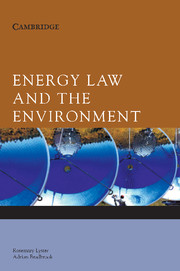Book contents
- Frontmatter
- Contents
- List of figures & tables
- Table of cases
- Table of statutes
- Preface
- 1 Overview of energy production and use in Australia
- 2 Energy technologies and sustainable development
- 3 Energy, international environmental law and sustainable development
- 4 Predicting the RPP for any given year
- 5 Sustainable energy in the Australian electricity and gas sectors
- 6 State government initiatives on energy and the environment
- 7 A sustainable energy law future for Australia
- Appendix A Draft non-legally binding Statement of Principles for a Global Consensus on Sustainable Energy Production and Consumption
- Appendix B Draft Protocol on Energy Efficiency and Renewable Energy to the United Nations Framework Convention on Climate Change
- Index
3 - Energy, international environmental law and sustainable development
Published online by Cambridge University Press: 05 June 2012
- Frontmatter
- Contents
- List of figures & tables
- Table of cases
- Table of statutes
- Preface
- 1 Overview of energy production and use in Australia
- 2 Energy technologies and sustainable development
- 3 Energy, international environmental law and sustainable development
- 4 Predicting the RPP for any given year
- 5 Sustainable energy in the Australian electricity and gas sectors
- 6 State government initiatives on energy and the environment
- 7 A sustainable energy law future for Australia
- Appendix A Draft non-legally binding Statement of Principles for a Global Consensus on Sustainable Energy Production and Consumption
- Appendix B Draft Protocol on Energy Efficiency and Renewable Energy to the United Nations Framework Convention on Climate Change
- Index
Summary
In this chapter the international environmental law and policy aspects that are relevant to energy law and the environment are assessed. The purpose of this is to discuss the many international instruments which have together shaped the parameters of what we now refer to as ‘a sustainable energy law framework’. Principal among these is the 1992 United Nations Framework Convention on Climate Change (UNFCCC), and its associated Kyoto Protocol, which require the stabilisation of global greenhouse gas emissions to 1990 levels. The reason that this instrument is so significant is that it is the stationary energy sector, reliant on the burning of fossil fuels, which is, globally, the biggest emitter of greenhouse gas emissions. It is also important to understand the basic underpinnings of the Rio Declaration and Agenda 21, which established the parameters for nations to move towards sustainable development. The energy and climate change outcomes of the 2002 World Summit on Sustainable Development and the G8 Gleneagles Summit 2005 will also be mentioned, as they enunciate the global community's most recent commitments to a program of action towards developing a sustainable energy framework.
The role of energy in international law
Although public international law has existed for many centuries, it is only since the 1970s that it has concerned itself with energy issues. Traditionally the legal regulation of energy issues has been regarded as a matter of domestic, rather than international law, and a matter that is exclusively for the States to resolve on an individual basis.
- Type
- Chapter
- Information
- Energy Law and the Environment , pp. 34 - 77Publisher: Cambridge University PressPrint publication year: 2006



